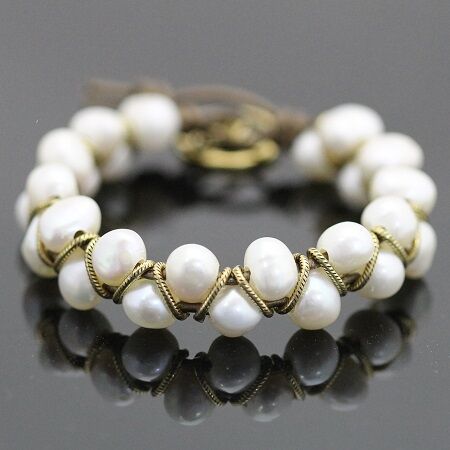Gemstone of the Month: Freshwater Pearls
Gemstone of the Month: Freshwater Pearls

Pearls, the birthstone of those born in June, have long been a highly prized gem. In ancient Rome, pearls were the most valuable gem available and the wealthy showed their importance by wearing ropes of them. Legends abound, including tales that Cleopatra drank a potion of powdered pearl to prove her love for Marc Antony. Pearls traditionally represent innocence, purity and feminine wisdom, thus pearls are often embroidered onto wedding gowns and veils and worn as bridal jewelry. In various cultures, pearls have been used for protection, to bring prosperity and in folk magic to strengthen love, friendship and beauty. In many Asian cultures, pearls are used as a cure for various ailments and to increase concentration. Modern New Age practitioners revere pearls for their connection to the moon, aiding intuition, emotional clarity and one’s connection with their higher self.
.
Pearls are an organic gem, which means they are created by biology. Other examples of organic gems include coral, mother of pearl and amber. Until the discovery of diamonds in the 1700’s, pearls were considered the rarest and most valuable gem in the world. Naturally created pearls are so valuable because thousands of oysters must be searched to find just one pearl. In the 1800’s, the Japanese perfected the art of freshwater oyster farming in their many freshwater lakes. They learned to culture pearls by inserting small shell beads into oysters. As the oysters deposit lustrous nacre onto the beads, beautiful cultured pearls are born. Most perfect round cultured pearls still come from Japan today, while the Chinese have developed cutting edge techniques for culturing different forms of freshwater pearls, with irregular surfaces and interesting shapes. Today, naturally occurring pearls cost thousands of dollars while perfectly matched round cultured pearls can cost hundreds. A wide range of freshwater pearls, cultured with lustrous natural nacre, are available at Bead World for prices ranging from $100.00 to just $3.00 per strand, depending on size, color and shape.
.
Real pearls can be easily distinguished from faux, or imitation, pearls. Try rubbing the pearl against your tooth. The nacre will feel a bit rough, while faux pearls will feel smooth and glassy.

Happy Beading!!
Recent Posts
-
"Abalone Sea" Dangle Earrings
"Abalone Sea" Dangle EarringsIn this tutorial, you'll blend delicate design with the luminescent bea …24th Apr 2024 -
"Gem Keeper" Chain Cage Pendant Necklace
"Gem Keeper" Chain Cage Pendant NecklaceNo hole no problem! Keep anything from gems with no holes, b …29th Mar 2024 -
Layered Beaded Charm Necklaces
Layered Beaded Charm NecklacesLayered necklaces are a fashion staple that adds depth and dimension t …26th Feb 2024




